Business Finance Report: Analyzing Financial Statements & Ratios
VerifiedAdded on 2023/06/18
|11
|2515
|319
Report
AI Summary
This report provides a comprehensive overview of business finance, starting with the fundamental concepts of financial management and its importance in ensuring a company's financial stability. It delves into the main financial statements, including the balance sheet, income statement, and cash flow statement, explaining their components and significance in understanding a company's financial position. The report also explores ratio analysis, focusing on profitability, liquidity, and efficiency ratios, and their role in assessing a company's performance and making informed investment decisions. Furthermore, it discusses strategies for improving financial performance, emphasizing the importance of cash flow analysis, corporate social responsibility, and cost control measures. The report concludes by highlighting the benefits of effective financial planning and management in achieving organizational goals and ensuring long-term sustainability. Desklib offers a variety of solved assignments and past papers for students seeking further assistance.
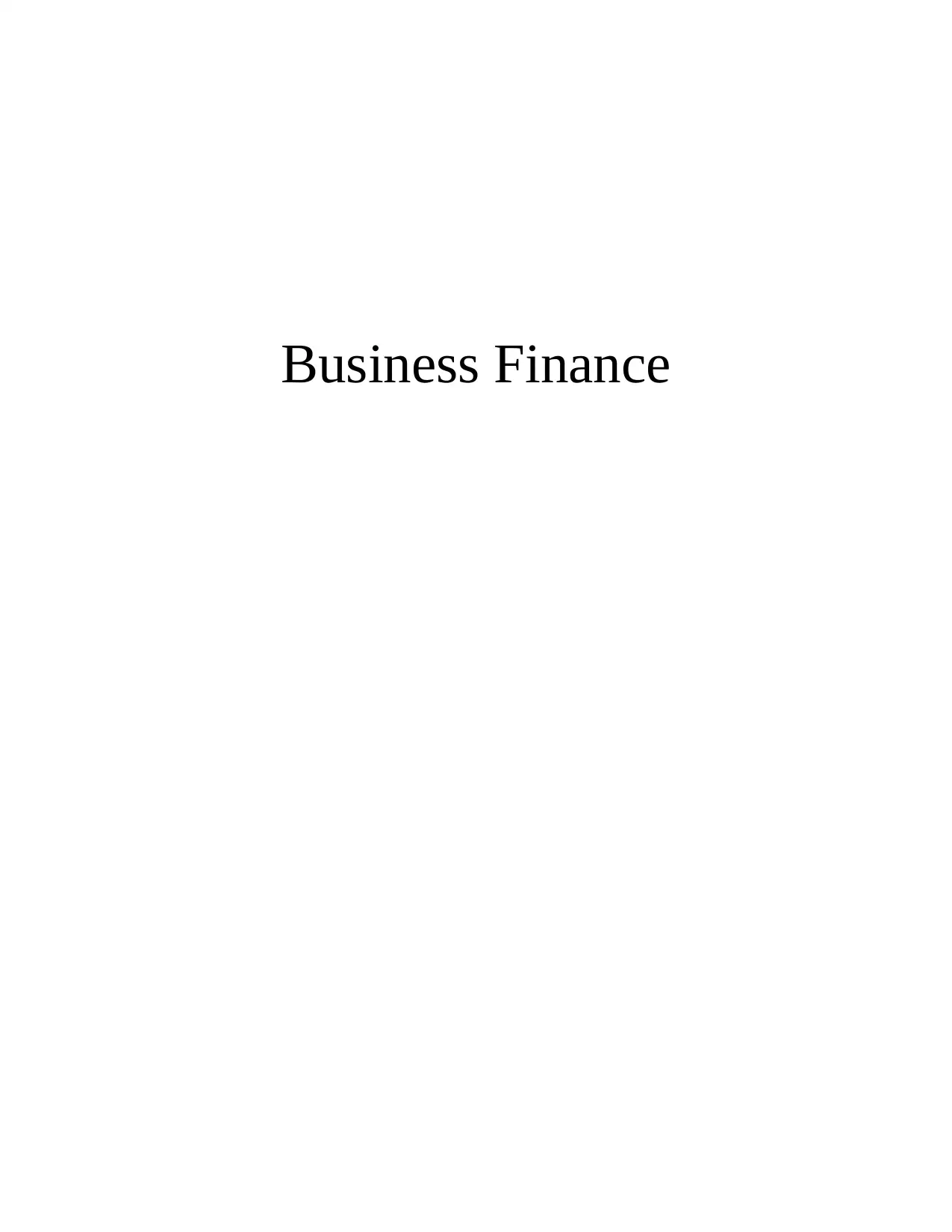
Business Finance
Paraphrase This Document
Need a fresh take? Get an instant paraphrase of this document with our AI Paraphraser
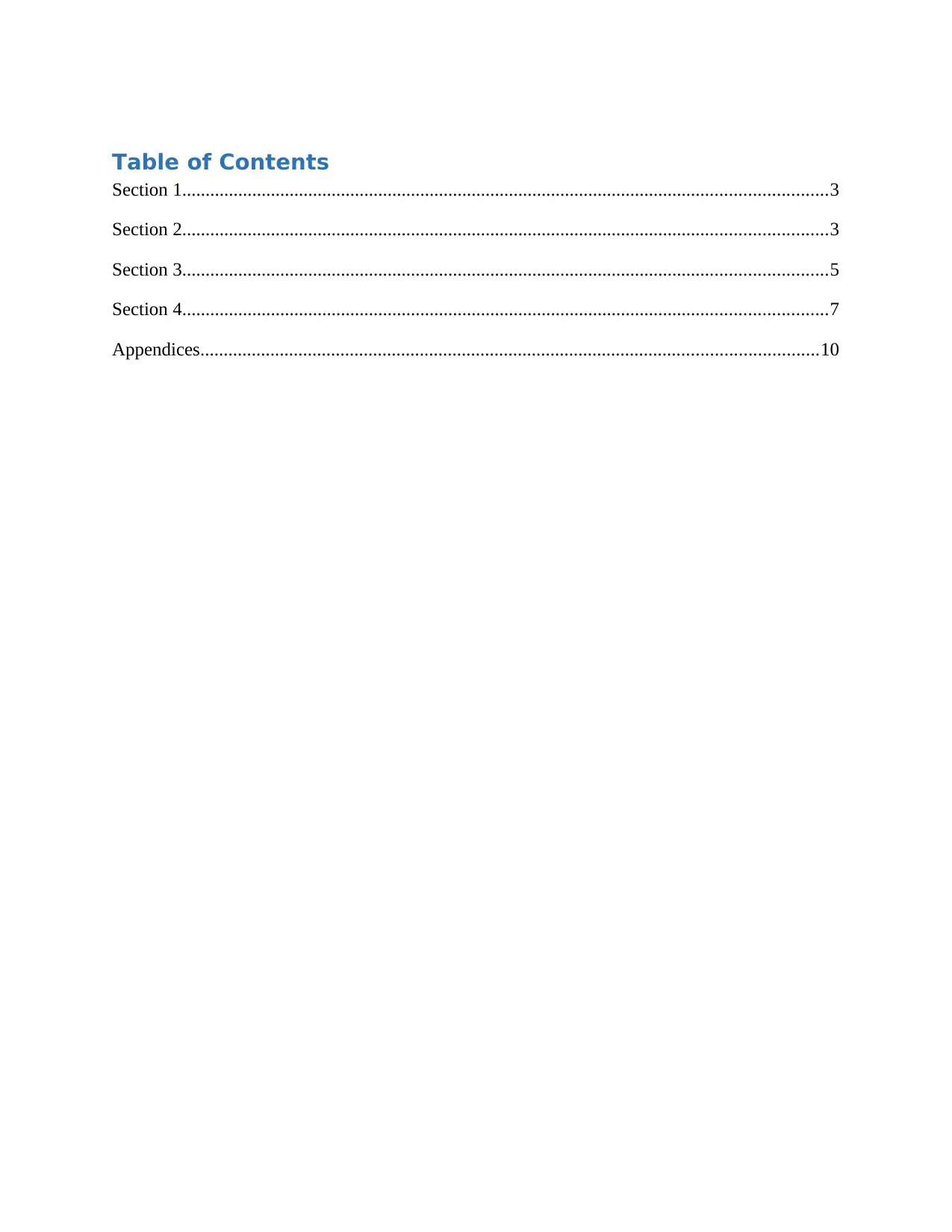
Table of Contents
Section 1..........................................................................................................................................3
Section 2..........................................................................................................................................3
Section 3..........................................................................................................................................5
Section 4..........................................................................................................................................7
Appendices....................................................................................................................................10
Section 1..........................................................................................................................................3
Section 2..........................................................................................................................................3
Section 3..........................................................................................................................................5
Section 4..........................................................................................................................................7
Appendices....................................................................................................................................10
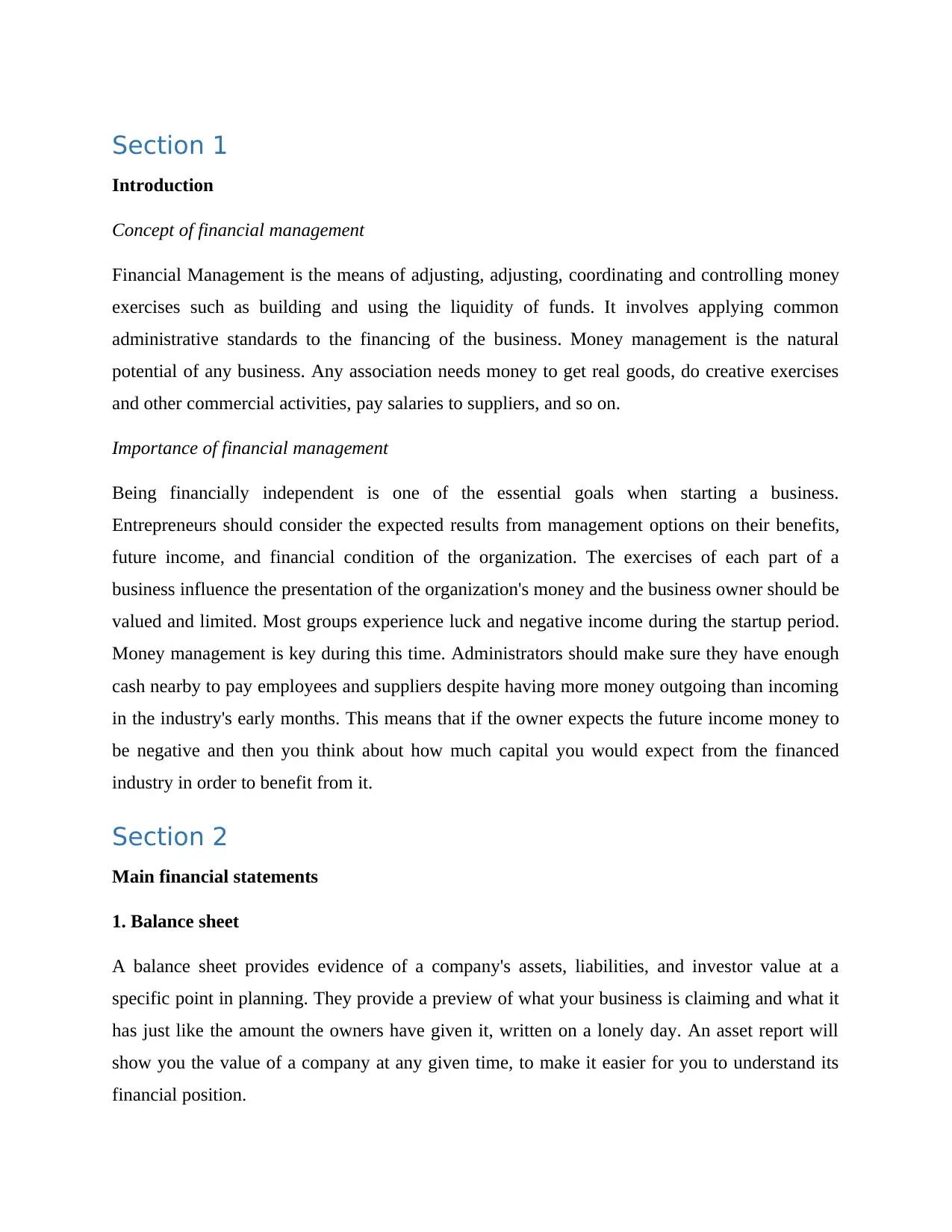
Section 1
Introduction
Concept of financial management
Financial Management is the means of adjusting, adjusting, coordinating and controlling money
exercises such as building and using the liquidity of funds. It involves applying common
administrative standards to the financing of the business. Money management is the natural
potential of any business. Any association needs money to get real goods, do creative exercises
and other commercial activities, pay salaries to suppliers, and so on.
Importance of financial management
Being financially independent is one of the essential goals when starting a business.
Entrepreneurs should consider the expected results from management options on their benefits,
future income, and financial condition of the organization. The exercises of each part of a
business influence the presentation of the organization's money and the business owner should be
valued and limited. Most groups experience luck and negative income during the startup period.
Money management is key during this time. Administrators should make sure they have enough
cash nearby to pay employees and suppliers despite having more money outgoing than incoming
in the industry's early months. This means that if the owner expects the future income money to
be negative and then you think about how much capital you would expect from the financed
industry in order to benefit from it.
Section 2
Main financial statements
1. Balance sheet
A balance sheet provides evidence of a company's assets, liabilities, and investor value at a
specific point in planning. They provide a preview of what your business is claiming and what it
has just like the amount the owners have given it, written on a lonely day. An asset report will
show you the value of a company at any given time, to make it easier for you to understand its
financial position.
Introduction
Concept of financial management
Financial Management is the means of adjusting, adjusting, coordinating and controlling money
exercises such as building and using the liquidity of funds. It involves applying common
administrative standards to the financing of the business. Money management is the natural
potential of any business. Any association needs money to get real goods, do creative exercises
and other commercial activities, pay salaries to suppliers, and so on.
Importance of financial management
Being financially independent is one of the essential goals when starting a business.
Entrepreneurs should consider the expected results from management options on their benefits,
future income, and financial condition of the organization. The exercises of each part of a
business influence the presentation of the organization's money and the business owner should be
valued and limited. Most groups experience luck and negative income during the startup period.
Money management is key during this time. Administrators should make sure they have enough
cash nearby to pay employees and suppliers despite having more money outgoing than incoming
in the industry's early months. This means that if the owner expects the future income money to
be negative and then you think about how much capital you would expect from the financed
industry in order to benefit from it.
Section 2
Main financial statements
1. Balance sheet
A balance sheet provides evidence of a company's assets, liabilities, and investor value at a
specific point in planning. They provide a preview of what your business is claiming and what it
has just like the amount the owners have given it, written on a lonely day. An asset report will
show you the value of a company at any given time, to make it easier for you to understand its
financial position.
⊘ This is a preview!⊘
Do you want full access?
Subscribe today to unlock all pages.

Trusted by 1+ million students worldwide
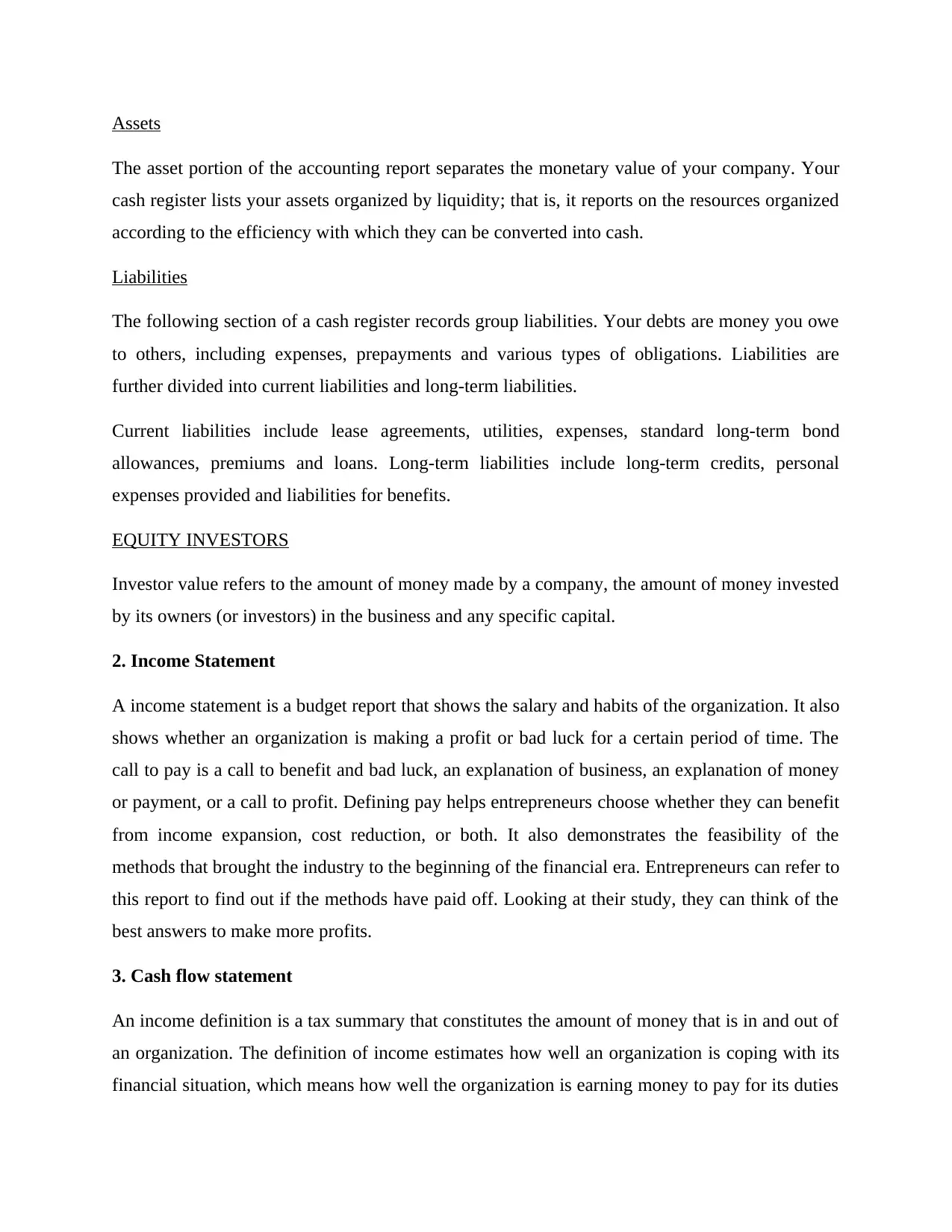
Assets
The asset portion of the accounting report separates the monetary value of your company. Your
cash register lists your assets organized by liquidity; that is, it reports on the resources organized
according to the efficiency with which they can be converted into cash.
Liabilities
The following section of a cash register records group liabilities. Your debts are money you owe
to others, including expenses, prepayments and various types of obligations. Liabilities are
further divided into current liabilities and long-term liabilities.
Current liabilities include lease agreements, utilities, expenses, standard long-term bond
allowances, premiums and loans. Long-term liabilities include long-term credits, personal
expenses provided and liabilities for benefits.
EQUITY INVESTORS
Investor value refers to the amount of money made by a company, the amount of money invested
by its owners (or investors) in the business and any specific capital.
2. Income Statement
A income statement is a budget report that shows the salary and habits of the organization. It also
shows whether an organization is making a profit or bad luck for a certain period of time. The
call to pay is a call to benefit and bad luck, an explanation of business, an explanation of money
or payment, or a call to profit. Defining pay helps entrepreneurs choose whether they can benefit
from income expansion, cost reduction, or both. It also demonstrates the feasibility of the
methods that brought the industry to the beginning of the financial era. Entrepreneurs can refer to
this report to find out if the methods have paid off. Looking at their study, they can think of the
best answers to make more profits.
3. Cash flow statement
An income definition is a tax summary that constitutes the amount of money that is in and out of
an organization. The definition of income estimates how well an organization is coping with its
financial situation, which means how well the organization is earning money to pay for its duties
The asset portion of the accounting report separates the monetary value of your company. Your
cash register lists your assets organized by liquidity; that is, it reports on the resources organized
according to the efficiency with which they can be converted into cash.
Liabilities
The following section of a cash register records group liabilities. Your debts are money you owe
to others, including expenses, prepayments and various types of obligations. Liabilities are
further divided into current liabilities and long-term liabilities.
Current liabilities include lease agreements, utilities, expenses, standard long-term bond
allowances, premiums and loans. Long-term liabilities include long-term credits, personal
expenses provided and liabilities for benefits.
EQUITY INVESTORS
Investor value refers to the amount of money made by a company, the amount of money invested
by its owners (or investors) in the business and any specific capital.
2. Income Statement
A income statement is a budget report that shows the salary and habits of the organization. It also
shows whether an organization is making a profit or bad luck for a certain period of time. The
call to pay is a call to benefit and bad luck, an explanation of business, an explanation of money
or payment, or a call to profit. Defining pay helps entrepreneurs choose whether they can benefit
from income expansion, cost reduction, or both. It also demonstrates the feasibility of the
methods that brought the industry to the beginning of the financial era. Entrepreneurs can refer to
this report to find out if the methods have paid off. Looking at their study, they can think of the
best answers to make more profits.
3. Cash flow statement
An income definition is a tax summary that constitutes the amount of money that is in and out of
an organization. The definition of income estimates how well an organization is coping with its
financial situation, which means how well the organization is earning money to pay for its duties
Paraphrase This Document
Need a fresh take? Get an instant paraphrase of this document with our AI Paraphraser
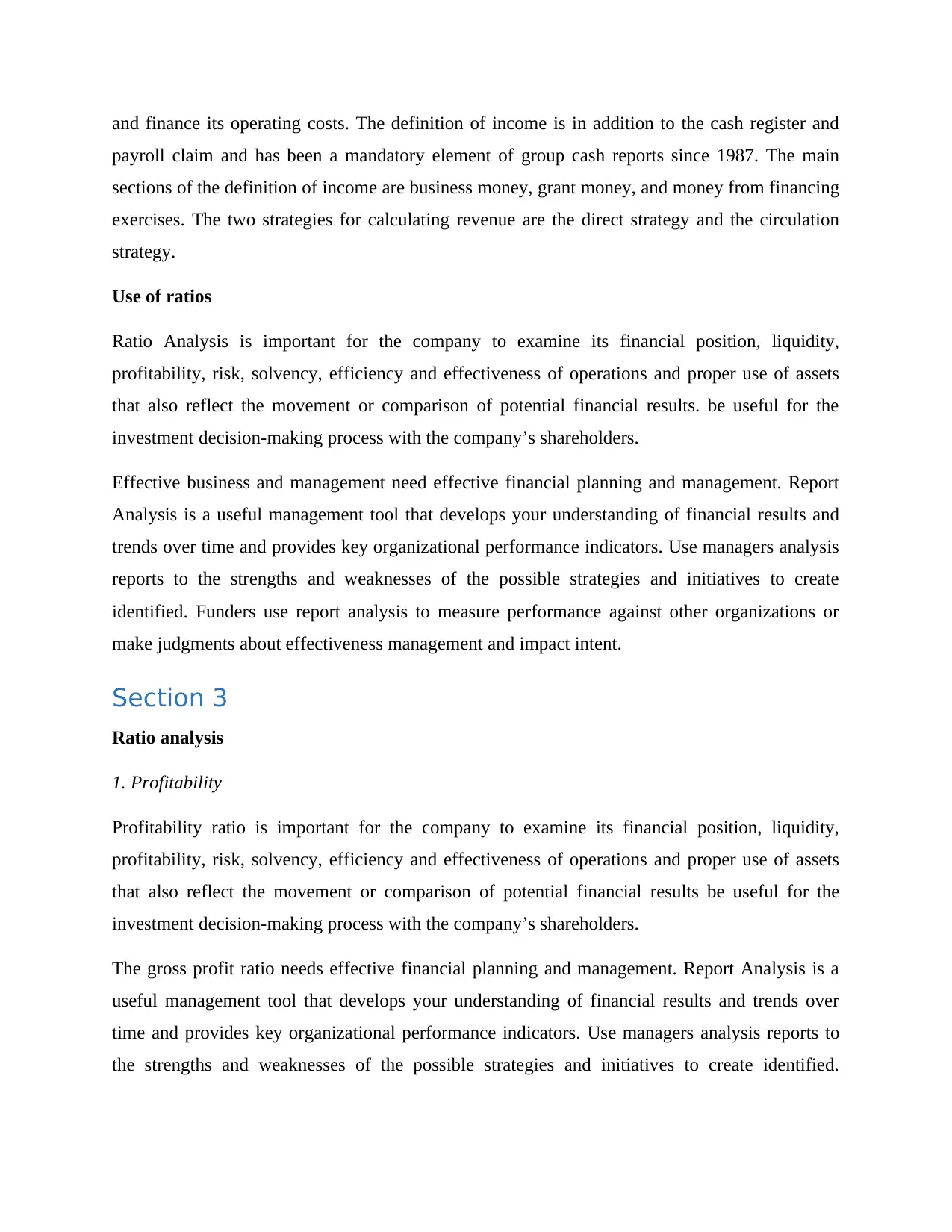
and finance its operating costs. The definition of income is in addition to the cash register and
payroll claim and has been a mandatory element of group cash reports since 1987. The main
sections of the definition of income are business money, grant money, and money from financing
exercises. The two strategies for calculating revenue are the direct strategy and the circulation
strategy.
Use of ratios
Ratio Analysis is important for the company to examine its financial position, liquidity,
profitability, risk, solvency, efficiency and effectiveness of operations and proper use of assets
that also reflect the movement or comparison of potential financial results. be useful for the
investment decision-making process with the company’s shareholders.
Effective business and management need effective financial planning and management. Report
Analysis is a useful management tool that develops your understanding of financial results and
trends over time and provides key organizational performance indicators. Use managers analysis
reports to the strengths and weaknesses of the possible strategies and initiatives to create
identified. Funders use report analysis to measure performance against other organizations or
make judgments about effectiveness management and impact intent.
Section 3
Ratio analysis
1. Profitability
Profitability ratio is important for the company to examine its financial position, liquidity,
profitability, risk, solvency, efficiency and effectiveness of operations and proper use of assets
that also reflect the movement or comparison of potential financial results be useful for the
investment decision-making process with the company’s shareholders.
The gross profit ratio needs effective financial planning and management. Report Analysis is a
useful management tool that develops your understanding of financial results and trends over
time and provides key organizational performance indicators. Use managers analysis reports to
the strengths and weaknesses of the possible strategies and initiatives to create identified.
payroll claim and has been a mandatory element of group cash reports since 1987. The main
sections of the definition of income are business money, grant money, and money from financing
exercises. The two strategies for calculating revenue are the direct strategy and the circulation
strategy.
Use of ratios
Ratio Analysis is important for the company to examine its financial position, liquidity,
profitability, risk, solvency, efficiency and effectiveness of operations and proper use of assets
that also reflect the movement or comparison of potential financial results. be useful for the
investment decision-making process with the company’s shareholders.
Effective business and management need effective financial planning and management. Report
Analysis is a useful management tool that develops your understanding of financial results and
trends over time and provides key organizational performance indicators. Use managers analysis
reports to the strengths and weaknesses of the possible strategies and initiatives to create
identified. Funders use report analysis to measure performance against other organizations or
make judgments about effectiveness management and impact intent.
Section 3
Ratio analysis
1. Profitability
Profitability ratio is important for the company to examine its financial position, liquidity,
profitability, risk, solvency, efficiency and effectiveness of operations and proper use of assets
that also reflect the movement or comparison of potential financial results be useful for the
investment decision-making process with the company’s shareholders.
The gross profit ratio needs effective financial planning and management. Report Analysis is a
useful management tool that develops your understanding of financial results and trends over
time and provides key organizational performance indicators. Use managers analysis reports to
the strengths and weaknesses of the possible strategies and initiatives to create identified.
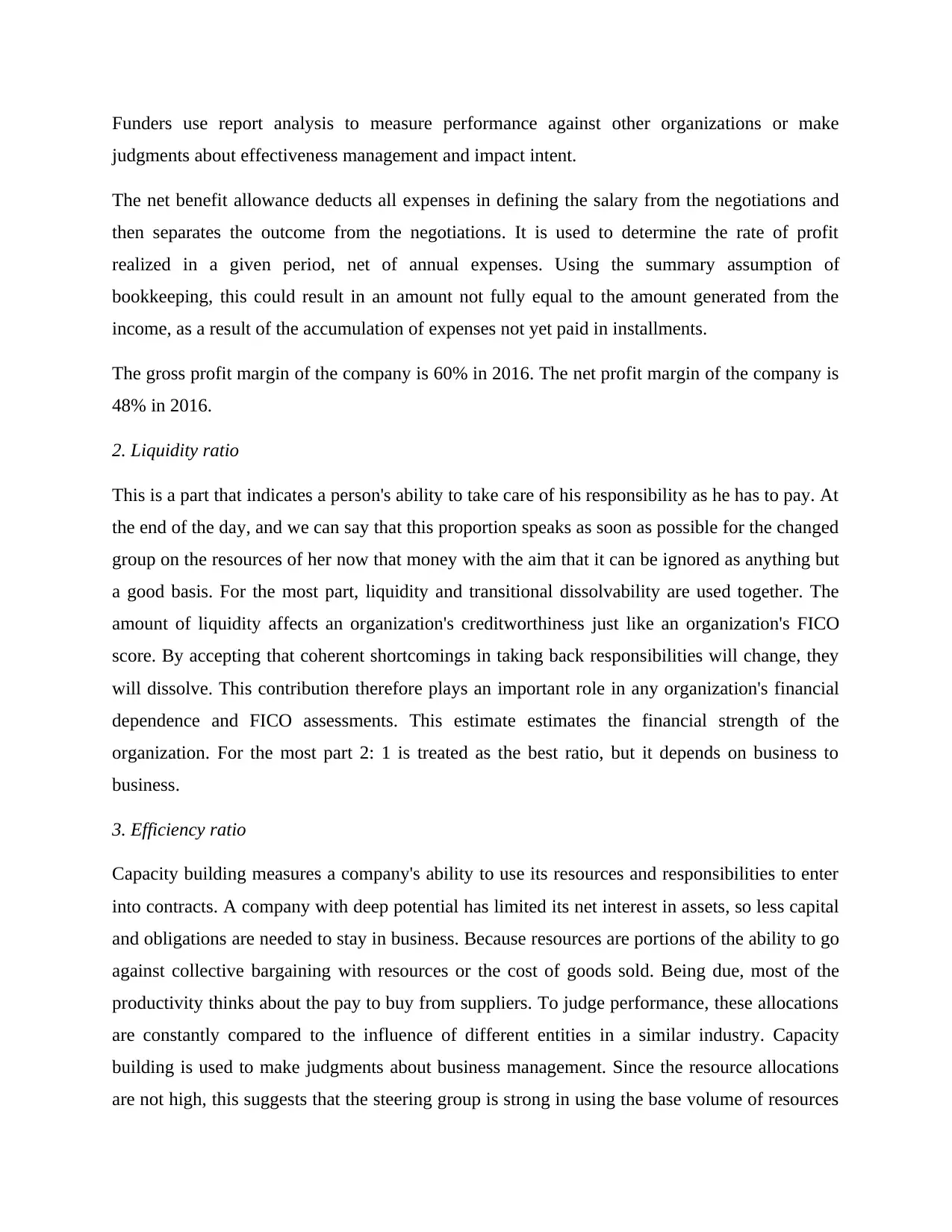
Funders use report analysis to measure performance against other organizations or make
judgments about effectiveness management and impact intent.
The net benefit allowance deducts all expenses in defining the salary from the negotiations and
then separates the outcome from the negotiations. It is used to determine the rate of profit
realized in a given period, net of annual expenses. Using the summary assumption of
bookkeeping, this could result in an amount not fully equal to the amount generated from the
income, as a result of the accumulation of expenses not yet paid in installments.
The gross profit margin of the company is 60% in 2016. The net profit margin of the company is
48% in 2016.
2. Liquidity ratio
This is a part that indicates a person's ability to take care of his responsibility as he has to pay. At
the end of the day, and we can say that this proportion speaks as soon as possible for the changed
group on the resources of her now that money with the aim that it can be ignored as anything but
a good basis. For the most part, liquidity and transitional dissolvability are used together. The
amount of liquidity affects an organization's creditworthiness just like an organization's FICO
score. By accepting that coherent shortcomings in taking back responsibilities will change, they
will dissolve. This contribution therefore plays an important role in any organization's financial
dependence and FICO assessments. This estimate estimates the financial strength of the
organization. For the most part 2: 1 is treated as the best ratio, but it depends on business to
business.
3. Efficiency ratio
Capacity building measures a company's ability to use its resources and responsibilities to enter
into contracts. A company with deep potential has limited its net interest in assets, so less capital
and obligations are needed to stay in business. Because resources are portions of the ability to go
against collective bargaining with resources or the cost of goods sold. Being due, most of the
productivity thinks about the pay to buy from suppliers. To judge performance, these allocations
are constantly compared to the influence of different entities in a similar industry. Capacity
building is used to make judgments about business management. Since the resource allocations
are not high, this suggests that the steering group is strong in using the base volume of resources
judgments about effectiveness management and impact intent.
The net benefit allowance deducts all expenses in defining the salary from the negotiations and
then separates the outcome from the negotiations. It is used to determine the rate of profit
realized in a given period, net of annual expenses. Using the summary assumption of
bookkeeping, this could result in an amount not fully equal to the amount generated from the
income, as a result of the accumulation of expenses not yet paid in installments.
The gross profit margin of the company is 60% in 2016. The net profit margin of the company is
48% in 2016.
2. Liquidity ratio
This is a part that indicates a person's ability to take care of his responsibility as he has to pay. At
the end of the day, and we can say that this proportion speaks as soon as possible for the changed
group on the resources of her now that money with the aim that it can be ignored as anything but
a good basis. For the most part, liquidity and transitional dissolvability are used together. The
amount of liquidity affects an organization's creditworthiness just like an organization's FICO
score. By accepting that coherent shortcomings in taking back responsibilities will change, they
will dissolve. This contribution therefore plays an important role in any organization's financial
dependence and FICO assessments. This estimate estimates the financial strength of the
organization. For the most part 2: 1 is treated as the best ratio, but it depends on business to
business.
3. Efficiency ratio
Capacity building measures a company's ability to use its resources and responsibilities to enter
into contracts. A company with deep potential has limited its net interest in assets, so less capital
and obligations are needed to stay in business. Because resources are portions of the ability to go
against collective bargaining with resources or the cost of goods sold. Being due, most of the
productivity thinks about the pay to buy from suppliers. To judge performance, these allocations
are constantly compared to the influence of different entities in a similar industry. Capacity
building is used to make judgments about business management. Since the resource allocations
are not high, this suggests that the steering group is strong in using the base volume of resources
⊘ This is a preview!⊘
Do you want full access?
Subscribe today to unlock all pages.

Trusted by 1+ million students worldwide
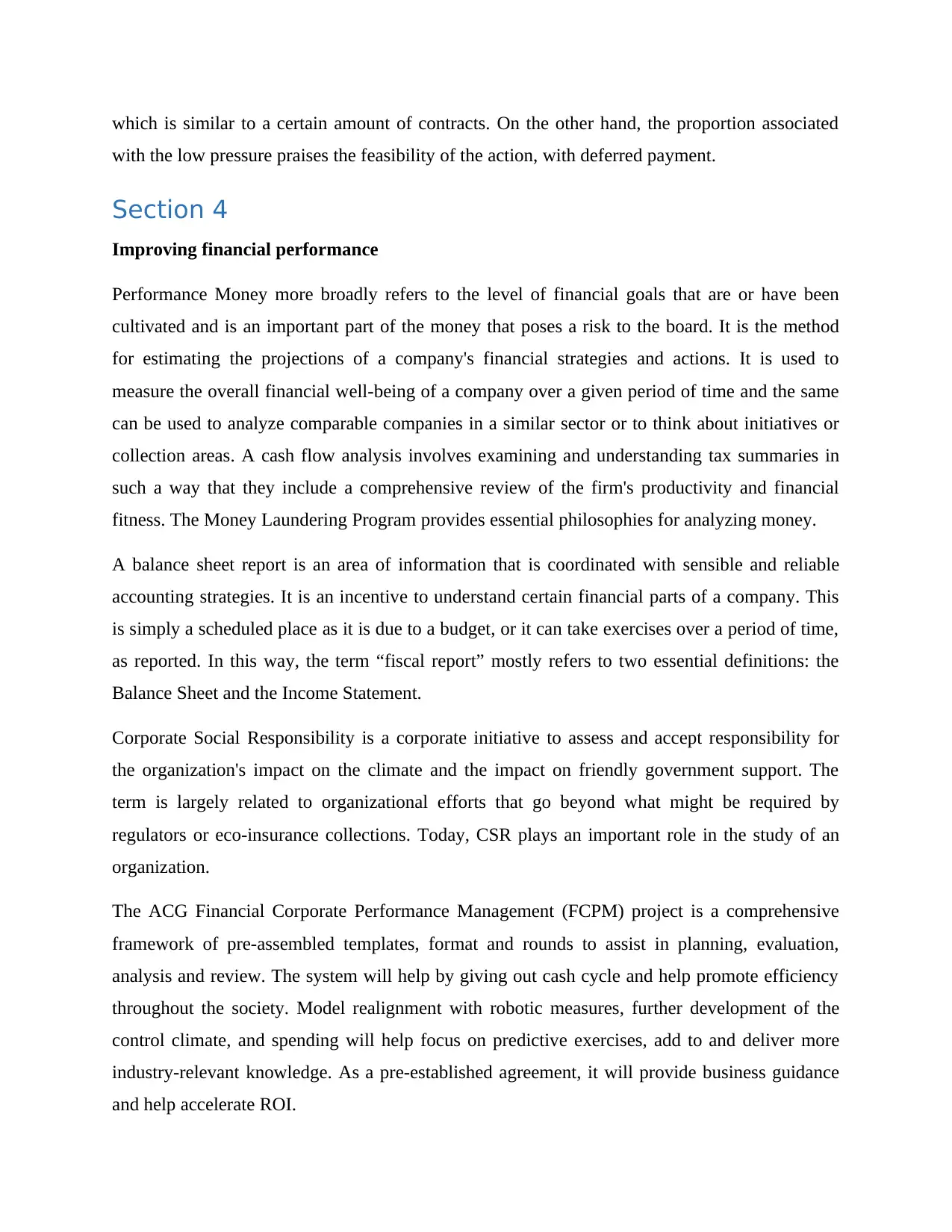
which is similar to a certain amount of contracts. On the other hand, the proportion associated
with the low pressure praises the feasibility of the action, with deferred payment.
Section 4
Improving financial performance
Performance Money more broadly refers to the level of financial goals that are or have been
cultivated and is an important part of the money that poses a risk to the board. It is the method
for estimating the projections of a company's financial strategies and actions. It is used to
measure the overall financial well-being of a company over a given period of time and the same
can be used to analyze comparable companies in a similar sector or to think about initiatives or
collection areas. A cash flow analysis involves examining and understanding tax summaries in
such a way that they include a comprehensive review of the firm's productivity and financial
fitness. The Money Laundering Program provides essential philosophies for analyzing money.
A balance sheet report is an area of information that is coordinated with sensible and reliable
accounting strategies. It is an incentive to understand certain financial parts of a company. This
is simply a scheduled place as it is due to a budget, or it can take exercises over a period of time,
as reported. In this way, the term “fiscal report” mostly refers to two essential definitions: the
Balance Sheet and the Income Statement.
Corporate Social Responsibility is a corporate initiative to assess and accept responsibility for
the organization's impact on the climate and the impact on friendly government support. The
term is largely related to organizational efforts that go beyond what might be required by
regulators or eco-insurance collections. Today, CSR plays an important role in the study of an
organization.
The ACG Financial Corporate Performance Management (FCPM) project is a comprehensive
framework of pre-assembled templates, format and rounds to assist in planning, evaluation,
analysis and review. The system will help by giving out cash cycle and help promote efficiency
throughout the society. Model realignment with robotic measures, further development of the
control climate, and spending will help focus on predictive exercises, add to and deliver more
industry-relevant knowledge. As a pre-established agreement, it will provide business guidance
and help accelerate ROI.
with the low pressure praises the feasibility of the action, with deferred payment.
Section 4
Improving financial performance
Performance Money more broadly refers to the level of financial goals that are or have been
cultivated and is an important part of the money that poses a risk to the board. It is the method
for estimating the projections of a company's financial strategies and actions. It is used to
measure the overall financial well-being of a company over a given period of time and the same
can be used to analyze comparable companies in a similar sector or to think about initiatives or
collection areas. A cash flow analysis involves examining and understanding tax summaries in
such a way that they include a comprehensive review of the firm's productivity and financial
fitness. The Money Laundering Program provides essential philosophies for analyzing money.
A balance sheet report is an area of information that is coordinated with sensible and reliable
accounting strategies. It is an incentive to understand certain financial parts of a company. This
is simply a scheduled place as it is due to a budget, or it can take exercises over a period of time,
as reported. In this way, the term “fiscal report” mostly refers to two essential definitions: the
Balance Sheet and the Income Statement.
Corporate Social Responsibility is a corporate initiative to assess and accept responsibility for
the organization's impact on the climate and the impact on friendly government support. The
term is largely related to organizational efforts that go beyond what might be required by
regulators or eco-insurance collections. Today, CSR plays an important role in the study of an
organization.
The ACG Financial Corporate Performance Management (FCPM) project is a comprehensive
framework of pre-assembled templates, format and rounds to assist in planning, evaluation,
analysis and review. The system will help by giving out cash cycle and help promote efficiency
throughout the society. Model realignment with robotic measures, further development of the
control climate, and spending will help focus on predictive exercises, add to and deliver more
industry-relevant knowledge. As a pre-established agreement, it will provide business guidance
and help accelerate ROI.
Paraphrase This Document
Need a fresh take? Get an instant paraphrase of this document with our AI Paraphraser
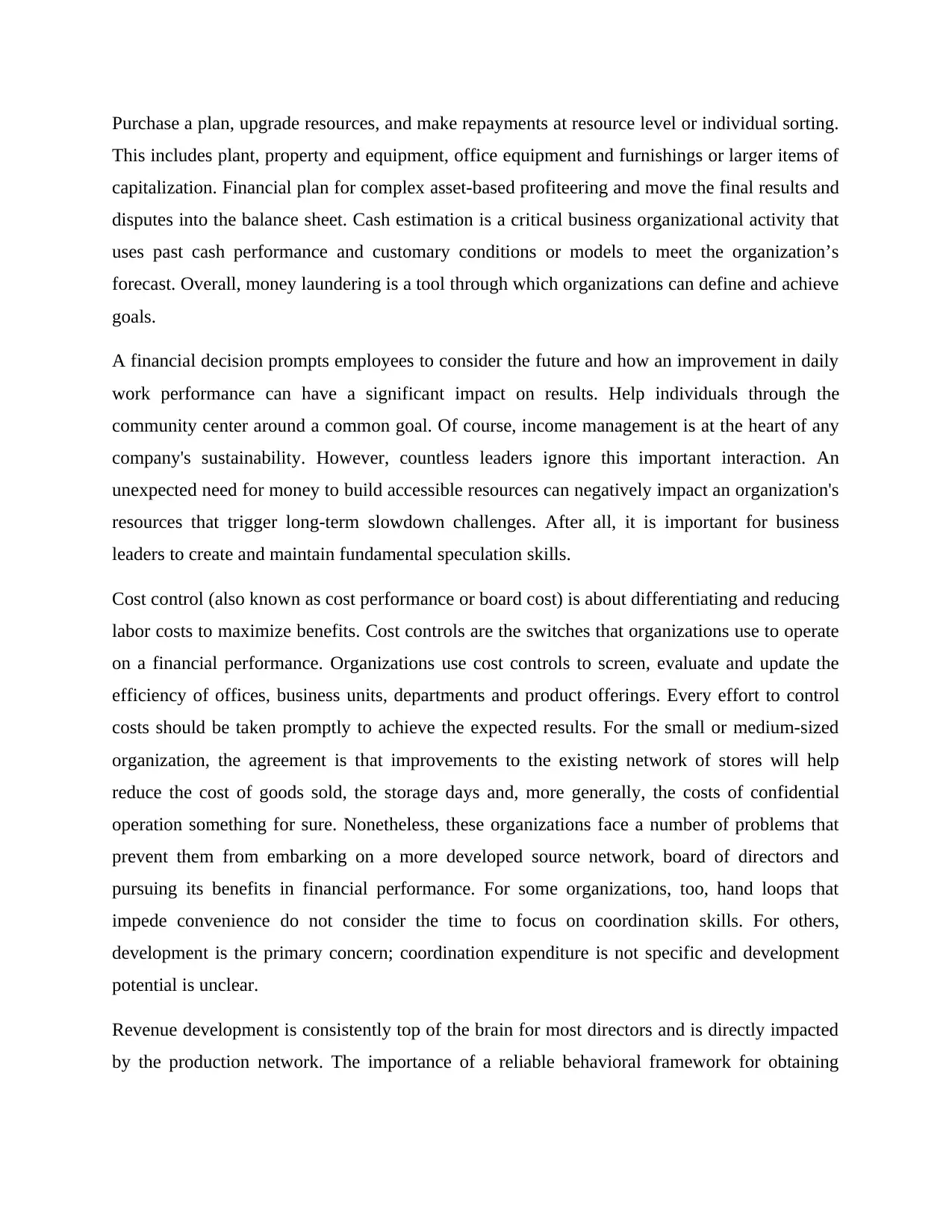
Purchase a plan, upgrade resources, and make repayments at resource level or individual sorting.
This includes plant, property and equipment, office equipment and furnishings or larger items of
capitalization. Financial plan for complex asset-based profiteering and move the final results and
disputes into the balance sheet. Cash estimation is a critical business organizational activity that
uses past cash performance and customary conditions or models to meet the organization’s
forecast. Overall, money laundering is a tool through which organizations can define and achieve
goals.
A financial decision prompts employees to consider the future and how an improvement in daily
work performance can have a significant impact on results. Help individuals through the
community center around a common goal. Of course, income management is at the heart of any
company's sustainability. However, countless leaders ignore this important interaction. An
unexpected need for money to build accessible resources can negatively impact an organization's
resources that trigger long-term slowdown challenges. After all, it is important for business
leaders to create and maintain fundamental speculation skills.
Cost control (also known as cost performance or board cost) is about differentiating and reducing
labor costs to maximize benefits. Cost controls are the switches that organizations use to operate
on a financial performance. Organizations use cost controls to screen, evaluate and update the
efficiency of offices, business units, departments and product offerings. Every effort to control
costs should be taken promptly to achieve the expected results. For the small or medium-sized
organization, the agreement is that improvements to the existing network of stores will help
reduce the cost of goods sold, the storage days and, more generally, the costs of confidential
operation something for sure. Nonetheless, these organizations face a number of problems that
prevent them from embarking on a more developed source network, board of directors and
pursuing its benefits in financial performance. For some organizations, too, hand loops that
impede convenience do not consider the time to focus on coordination skills. For others,
development is the primary concern; coordination expenditure is not specific and development
potential is unclear.
Revenue development is consistently top of the brain for most directors and is directly impacted
by the production network. The importance of a reliable behavioral framework for obtaining
This includes plant, property and equipment, office equipment and furnishings or larger items of
capitalization. Financial plan for complex asset-based profiteering and move the final results and
disputes into the balance sheet. Cash estimation is a critical business organizational activity that
uses past cash performance and customary conditions or models to meet the organization’s
forecast. Overall, money laundering is a tool through which organizations can define and achieve
goals.
A financial decision prompts employees to consider the future and how an improvement in daily
work performance can have a significant impact on results. Help individuals through the
community center around a common goal. Of course, income management is at the heart of any
company's sustainability. However, countless leaders ignore this important interaction. An
unexpected need for money to build accessible resources can negatively impact an organization's
resources that trigger long-term slowdown challenges. After all, it is important for business
leaders to create and maintain fundamental speculation skills.
Cost control (also known as cost performance or board cost) is about differentiating and reducing
labor costs to maximize benefits. Cost controls are the switches that organizations use to operate
on a financial performance. Organizations use cost controls to screen, evaluate and update the
efficiency of offices, business units, departments and product offerings. Every effort to control
costs should be taken promptly to achieve the expected results. For the small or medium-sized
organization, the agreement is that improvements to the existing network of stores will help
reduce the cost of goods sold, the storage days and, more generally, the costs of confidential
operation something for sure. Nonetheless, these organizations face a number of problems that
prevent them from embarking on a more developed source network, board of directors and
pursuing its benefits in financial performance. For some organizations, too, hand loops that
impede convenience do not consider the time to focus on coordination skills. For others,
development is the primary concern; coordination expenditure is not specific and development
potential is unclear.
Revenue development is consistently top of the brain for most directors and is directly impacted
by the production network. The importance of a reliable behavioral framework for obtaining

advertising material should be clarified. Be that as it may, the essence of the impact of
transportation on revenue goes beyond delivering the item to the customer.
transportation on revenue goes beyond delivering the item to the customer.
⊘ This is a preview!⊘
Do you want full access?
Subscribe today to unlock all pages.

Trusted by 1+ million students worldwide
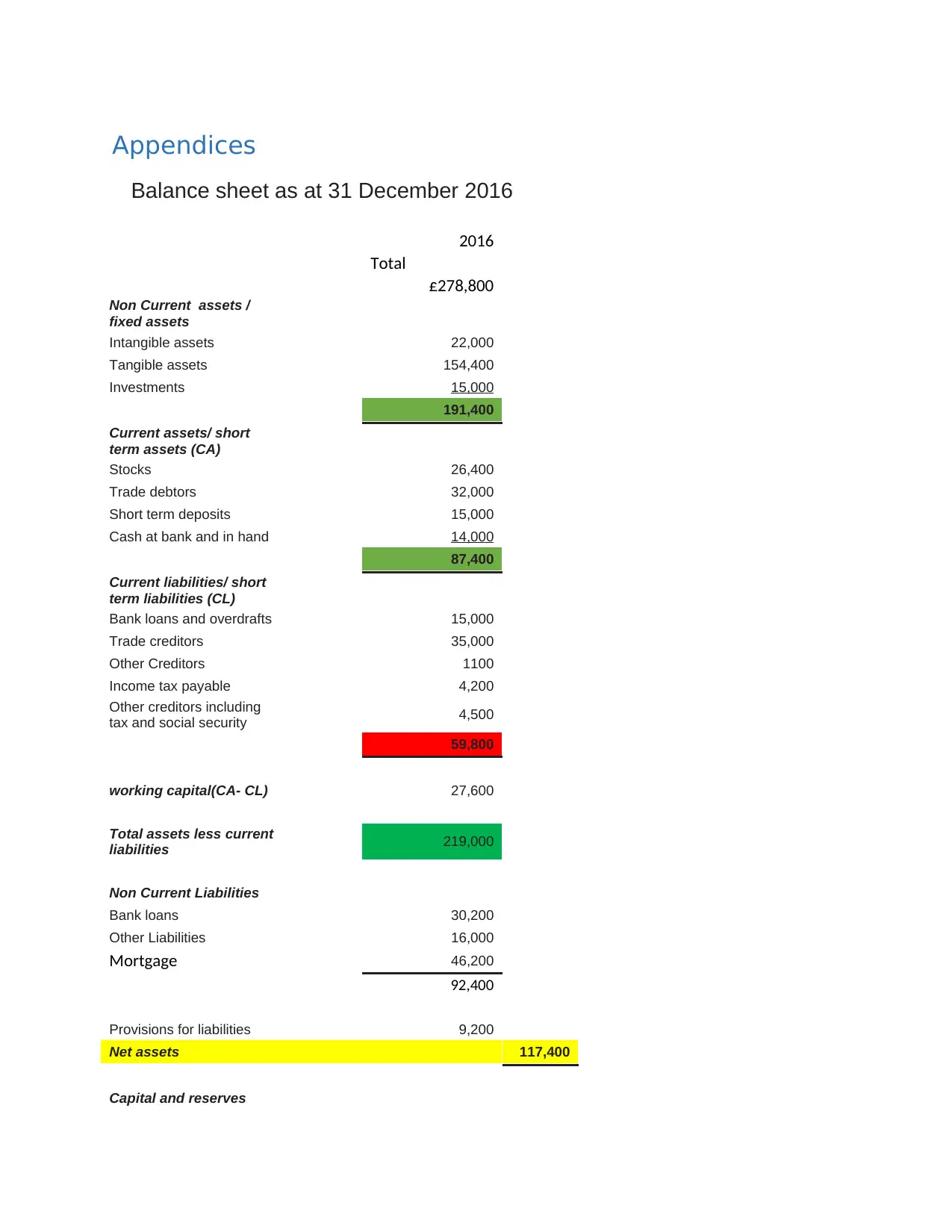
Appendices
Balance sheet as at 31 December 2016
2016
Total
£278,800
Non Current assets /
fixed assets
Intangible assets 22,000
Tangible assets 154,400
Investments 15,000
191,400
Current assets/ short
term assets (CA)
Stocks 26,400
Trade debtors 32,000
Short term deposits 15,000
Cash at bank and in hand 14,000
87,400
Current liabilities/ short
term liabilities (CL)
Bank loans and overdrafts 15,000
Trade creditors 35,000
Other Creditors 1100
Income tax payable 4,200
Other creditors including
tax and social security 4,500
59,800
working capital(CA- CL) 27,600
Total assets less current
liabilities 219,000
Non Current Liabilities
Bank loans 30,200
Other Liabilities 16,000
Mortgage 46,200
92,400
Provisions for liabilities 9,200
Net assets 117,400
Capital and reserves
Balance sheet as at 31 December 2016
2016
Total
£278,800
Non Current assets /
fixed assets
Intangible assets 22,000
Tangible assets 154,400
Investments 15,000
191,400
Current assets/ short
term assets (CA)
Stocks 26,400
Trade debtors 32,000
Short term deposits 15,000
Cash at bank and in hand 14,000
87,400
Current liabilities/ short
term liabilities (CL)
Bank loans and overdrafts 15,000
Trade creditors 35,000
Other Creditors 1100
Income tax payable 4,200
Other creditors including
tax and social security 4,500
59,800
working capital(CA- CL) 27,600
Total assets less current
liabilities 219,000
Non Current Liabilities
Bank loans 30,200
Other Liabilities 16,000
Mortgage 46,200
92,400
Provisions for liabilities 9,200
Net assets 117,400
Capital and reserves
Paraphrase This Document
Need a fresh take? Get an instant paraphrase of this document with our AI Paraphraser
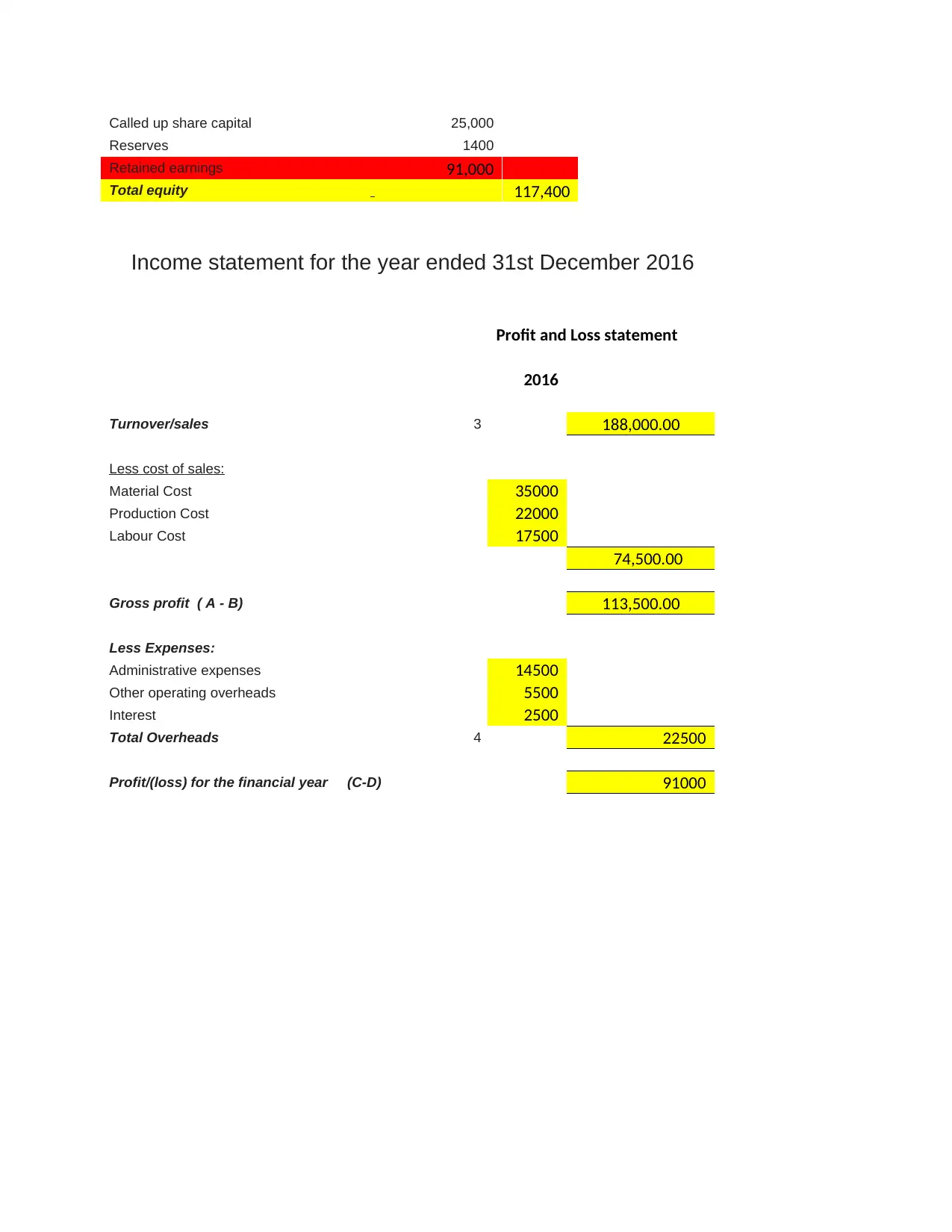
Called up share capital 25,000
Reserves 1400
Retained earnings 91,000
Total equity 117,400
Income statement for the year ended 31st December 2016
Profit and Loss statement
2016
Turnover/sales 3 188,000.00
Less cost of sales:
Material Cost 35000
Production Cost 22000
Labour Cost 17500
74,500.00
Gross profit ( A - B) 113,500.00
Less Expenses:
Administrative expenses 14500
Other operating overheads 5500
Interest 2500
Total Overheads 4 22500
Profit/(loss) for the financial year (C-D) 91000
Reserves 1400
Retained earnings 91,000
Total equity 117,400
Income statement for the year ended 31st December 2016
Profit and Loss statement
2016
Turnover/sales 3 188,000.00
Less cost of sales:
Material Cost 35000
Production Cost 22000
Labour Cost 17500
74,500.00
Gross profit ( A - B) 113,500.00
Less Expenses:
Administrative expenses 14500
Other operating overheads 5500
Interest 2500
Total Overheads 4 22500
Profit/(loss) for the financial year (C-D) 91000
1 out of 11
Related Documents
Your All-in-One AI-Powered Toolkit for Academic Success.
+13062052269
info@desklib.com
Available 24*7 on WhatsApp / Email
![[object Object]](/_next/static/media/star-bottom.7253800d.svg)
Unlock your academic potential
Copyright © 2020–2025 A2Z Services. All Rights Reserved. Developed and managed by ZUCOL.




